Bread and also Puppet
from Monday, June15th of the year2009.
So last weekend, I went to the Bread and Puppet museum in Glover, VT. Weirdly, and luckily, they were doing a little exposition-stroke-open house at the same time. Now. I grew up going to Bread and Puppet; for those readers not in the know, Bread and Puppet is/was a…well, it’s hard to describe. Let’s start with their self-description:
All Bread and Puppet Theater shows, created and designed by Peter Schumann with input from the company, use music, dance and slapstick to get their point across. Their distinctive imagery “” featuring puppets (of all kinds and sizes), masks, costumes, paintings, buildings, and landscapes “” seemingly breathe with Schumann’s distinctive visual style of dance, expressionism, dark humor and low-culture simplicity.
Okay cool. The Wikipedia entry is actually pretty good, as far as things go. As a kid, though, the ritual was that we would drive up to Northern Vermont (from Central Vermont, about two hours) and park the car on a back road, then hike a little ways through a dirt and hay path. The smell was very specific to that place: wet hay, hippies, distant smoke. We arrived just in time to stake out a piece of real-estate on a 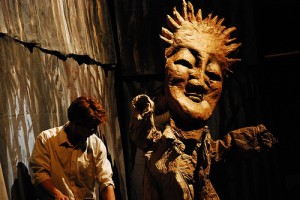 grassy hill, throw down a blanket, and walk into a pine forest filled with little strange tableaux and baby pieces of political puppet theater. This being the 80’s, a lot of it was kind of anti-Reagan, anti- (or pro-?) whatever messed up stuff happens in South America, anti-TV. Then, we’d gather back on the hillside and watch about a half an hour of political slapstick puppets marked with occasional shapenote singing: stilts, goofball kids tumbling around, mostly in service of the same political ideas from the pine trees. Then, after a little break, there was a fully silent pageant, during which gigantic puppets would slowly emerge from the distant woods and move closer to us. It is very difficult to recreate in words the effect that this silent theater had on me as a kid ““ whenever I see, for instance, Robert Wilson’s work it always reminds me immediately of Bread & Puppet “” not only the more obvious stage works, but smaller, weirder works like his Stations of the Cross. Then, all the giant puppets from the new ENO/Met production of Satyagraha reminded me so specifically of the pageant monsters “” B&P represents a sort of artistic node for me: a reference point rather than a referant, if that makes any sense. This image (taken from Wikipedia) sums some of it up:
grassy hill, throw down a blanket, and walk into a pine forest filled with little strange tableaux and baby pieces of political puppet theater. This being the 80’s, a lot of it was kind of anti-Reagan, anti- (or pro-?) whatever messed up stuff happens in South America, anti-TV. Then, we’d gather back on the hillside and watch about a half an hour of political slapstick puppets marked with occasional shapenote singing: stilts, goofball kids tumbling around, mostly in service of the same political ideas from the pine trees. Then, after a little break, there was a fully silent pageant, during which gigantic puppets would slowly emerge from the distant woods and move closer to us. It is very difficult to recreate in words the effect that this silent theater had on me as a kid ““ whenever I see, for instance, Robert Wilson’s work it always reminds me immediately of Bread & Puppet “” not only the more obvious stage works, but smaller, weirder works like his Stations of the Cross. Then, all the giant puppets from the new ENO/Met production of Satyagraha reminded me so specifically of the pageant monsters “” B&P represents a sort of artistic node for me: a reference point rather than a referant, if that makes any sense. This image (taken from Wikipedia) sums some of it up:
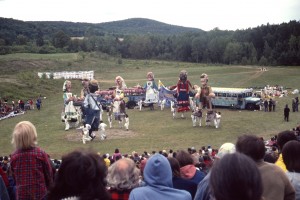
So it was a little depressing last week to see it been executed by college kids who were younger than I am. It was about a bunch of 23 year-olds with REALLY dippy smiles ““ like, you know I wouldn’t lie to you when I say that the girl with the drum and cymbals had the Single Dippiest Smile Ever. The full Circus & Paj haven’t happened since the late 90’s when the B&P world merged with the remnants of the Deadheads and Phishheads (sp?), so what’s left appear to be pretty wretched, underthought political theater the point of which appeared to be “down with bosses.” Can’t we do better than that? The sacred harp tune, Captain Kidd, which began all the circuses, reads (huge caveat here: I know the original text does not read in this fashion, and I know this poem is a repurposing of the tune, but as you might imagine the sacred harp community doesn’t have the most extensive online resource, and it’s too early to call Mary Alice to figure out the actual citation for this but ANYWAY, they all used to sing it like this here:)
Through all this world below, God we see all around.
Search hills and valleys through: there He’s found.
In growing fields of corn, the lily and the thorn,
The pleasant and forlorn, all declare, “God is there.”
In meadows dressed in green, there He’s seen.Then let my station be here in life where I see
The sacred Trinity. All agree:
In all the works He’s made, the forest and the glade,
Nor let me be afraid, though I dwell in the hill
Where nature’s works declare, “God is there.”
Now, in my (maybe flawed) memory, I feel like the stuff I saw in the 80’s was true to this philosophy. But now, I feel like it’s wandered off into a kind of depressing freshman year of college space. Maybe it’s a messed up memory issue, but at the end of this interminable performance, I wandered down from the dirt floor theater and found the old pine forest, with memorials to dead company members:
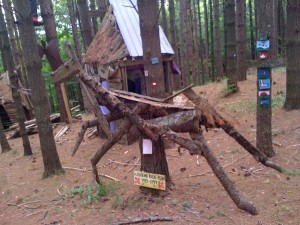
and the natural amphitheater:
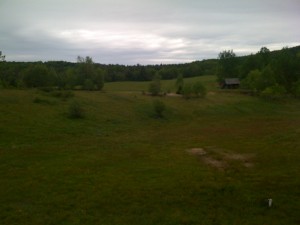
…and all the great icons came back to me, and I thought, well, maybe it’s better if I just keep it all there, as a repository of memories, icons, effigies, and smells.
Speaking of which, I’ve been thinking a lot about this picture of a Yup’ik Shaman:
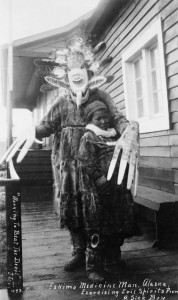
as a potential source for something. I’m not sure really what, but I’m feeling a big hand for Winter 2010.
I know that I’ve been yammering about it for months both in this space and on Twitter, but you guys. David Lang’s The Little Match Girl Passion is really worth your time. Let me break it down for you. The original story, by Hans Christian Andersen (Den Lille Pige med Svovlstikkerne – did anybody else know they called them “Sulfur Sticks?”) essentially describes a poor girl who has to stay out selling matches all night on New Year’s Eve for fear of being beaten by her father. To keep herself warm, she lights match after match, and in so doing, has a series of Radiant Visions of her grandmother and roasted Goose and various Holiday Pleasures. She dies, and the next morning, the people who find her body see her smiling, and they themselves have no idea of the Pleasures she had seen during her Mystics Visz. K. So David Lang turned this whole thing into a Passion Play for four singers, each playing one or two percussive instruments. What this essentially means is that he gave himself license to stylize the shit out of the text, and added some Christy bits and some Folksy bits and gave the bass-baritone a drum. It’s so genius. The piece is, in a sense, an incredibly minimalist exercise. There are three basic ways in which each singer can sing:
1. Normal, conversational syllables: 8th notes with a syllable per note, declamatory.
2. Irregular 5’s and 4’s and 3’s: little shopping lists of repeated words: come come come come come come come come come come, when when when when when when when when when. Twitchy and radiant.
3. Incredibly expressive long lines.
Check it “” an excerpt from the 13th movement:
[audio:LMGPWhenIt.mp3]
13. When it is time for me to go
Teggist:
When it is time for me to go
Don’t go from me
When it is time for me to leave
Don’t leave me
When it is time for me to die
Stay with me
When I am most scared
Stay with me
With such an Å“conomý of gesture, you’d think it would be sort of passion-free, but focus on the section from 2:26 onwards. When the second female voice is incanting I, I, I, I, I, I with all those diphthongs, and the bass is all up in the sky, and then she drops it down with that low g? Mmm.
Then check out this:
[audio:LMGPSiggithHour.mp3]
6. From the sixth hour
Well. Isn’t this the most beautiful Pergolesi’d out, full allegri thing you ever heard? Good work, David Lang. It’s like taking all the formulas and restrictions of minimalism and making them serve the gospel: tenths in the voice, controlling the vibrato… It’s such a great trick.
Everybody needs to buy this at this time. iTunes link here. Amazon link here.
One side note here. Vibrato in so-called minimalist music is a whole point of contention; Steve Reich’s scores tend to be really aggressively notated about vibrato; Different Trains, for instance, is traditionally played with none. However, more recently, I hear some sneaking into composer-approved pieces, like the Triple Quartet. David Lang seems more chill about it, but I wonder what this piece would sound like recorded with full straight tone.
I have been making many Syrups recently. The syrup I am making at this time consists of three enormous peeled and sliced ginger roots, one cup of sugar, and two and one half cups of water boiled down, with a bunch of black peppercorns, one fresh hot pepper, and star anise. The end result is a mahogany syrup that works really well when shook-upp with tequila, lime juice, and a little glyph of fresh ginger, muddled.
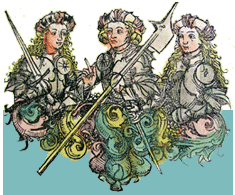
8 Comments
June 15th, 2009 at 9:15 pm
Ok, I read this blog too much… this I know from the fact that I am the first comment. But, I’m really glad you mentioned the match girl passion. It essential ended my entire life when I first heard it on the Carnegie Hall site a few months ago… and now I’m buying that recorded version which I – didn’t – even -KnOw – EXISTED!!! .. phew, I’m excited.
June 15th, 2009 at 11:52 pm
Big hands, you say? You want big hands? Surely what you want is Mme. Jessye Norman with The Biggest Hands in a Lion King Butoh Easter Island Extravaganza.
Also I wrote this thing about vibrato in minimalism this one time. (The vibrato part is at the end.)
June 17th, 2009 at 1:14 pm
You got the smell right. Eau de Woodstock …..grass trampled and rotting in the mud, unwashed (hairy) bodies. And I think you’re right that , at the end of each day’s events….thousands of people waiting in line for a slice of whole grain bread and a schmear of aioli, the Bread and Puppet sacrament, the wacky, exuberant, inventive circus …it was the pageant that you really miss, the pageant that made out of the simplistic, heartfelt slogans in the woodland shrines something truly sublime. It was visual theater on a scale that didn’t exist anywhere else, built, as you say, on silence, but also on an amazing theatrical exuberance and the use of time as a dramatic element.
There in the infield were the peasants or workers or farmers, depending on that year’s script, moon-faced, huddled in little huts, over the course of an hour, menaced by snarling, prancing gorillas, or some other dramatization of the horrible demons of wall street or the military. Finally, the ogre du jour was wheeled in, a sixty foot tall puppet capitalist, or overseer or general, towering malevolence. And then, just at dusk, in the corner of your eye, white floating shapes, maybe half a mile distant, resolving into cranes with ten foot wingspreads, slowly, slowly ‘flying’ closer. By the time they arrived, wings held aloft by running figures in white, the giant effigy was engulfed in flames. It was transcendent. You’re right, keep it in memory.
………Only better if we had brought along a shaker of tequila with your new syrup.
June 17th, 2009 at 7:16 pm
Hey Nico
the song was Captain Kidd and one year Peter and I got to sing a duet in front of the many thousands gathered as part of the pageant: it was Chickens in the Garden from the Waterson family in England. We lived at Bread and Puppet from Oct. till Feb. with Trudi Cohen and John Bell. To be in the sugar bush and the pine forest in the winter was something. We ate schmaltz with Peter S. and snapps, sang shape note and gospel quartets with Trudi and John at breakfast, lunch and dinner: good food.
June 17th, 2009 at 7:17 pm
oops, now I see that you knew it was Captain Kidd; did you mean by citation the collection it came from? I think it was the Social Harp and I’ll have to check the author (Peter knows) at home.
July 3rd, 2009 at 2:28 pm
Hey Nico,
Been enjoying your rants and snippets of sound and observations and recipes. Keep it all coming! I figured I owed you a bit in return, for making much of a small thing that appeared here–the ginger syrup. I’ve gone mad with it–see July 3 entry of website above.
July 3rd, 2009 at 2:28 pm
oops dumb–sorry about all those comments–I thought my internet connection crashed again.
July 9th, 2009 at 1:10 am
Oh gosh. I just imploded. Those excerpts are amazing.